The deep valleys of Himachal’s Lahaul & Spiti district introduce visitors to the splendour and magnificence of the epic Himalayas long before they reach Ladakh. Despite the depredations of succeeding generations and dawn of the new era of mass tourism, these scenic valleys remain largely untouched by civilisation and commercialisation. Amrita Bose reports
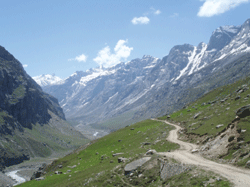 In 1901 Rudyard Kipling’s famous character Kim, who visited the Spiti valley in the foothills of the Himalayas, was moved to exclaim: “Surely the gods live here. This is no place for man.”
In 1901 Rudyard Kipling’s famous character Kim, who visited the Spiti valley in the foothills of the Himalayas, was moved to exclaim: “Surely the gods live here. This is no place for man.”
Much before Kipling, Chinese Buddhist voyager Heuin Tsang, who travelled to the Kullu and Spiti valleys during the seventh century AD, was also astonished by the beauty of the region especially the Chandratal Lake, which he described as the Lohitya Sarovar (‘Red lake’). Fortunately despite the depredations of succeeding generations and dawn of the new era of mass tourism in the 20th century, the valleys of Lahaul & Spiti remain largely untouched by civilisation and commercialisation. This Devbhumi (‘land of Gods’) is as scenic and serene as it was when the first outsiders traversed it.
The deep valleys of the Lahaul & Spiti district of Himachal Pradesh are sited between Tibet (China) to the east and Ladakh, a district of the Indian state of Jammu and Kashmir, to the north. The region is mostly ignored by tourists who prefer visiting the more publicised Ladakh and monasteries and mountain trails of its administrative capital, Leh. But Lahaul & Spiti introduce the visitor to the splendour and magnificence of the epic Himalayas long before they reach Ladakh. The towering mountains which surround the valleys attract mountaineers, trekkers, bikers, cyclists and travellers from around the world.
Lahaul & Spiti constitute the largest district of the northern region of Himachal Pradesh (pop. 6 million), and retain a distinct identity. Buddhism is the predominant religion, which explains the landscape scattered with ancient gompas or monasteries, some of them dating back to the 10th century. The Lahaul valley is a vast (13,834 sq. km) green grassland which is covered with eye-soothing alpine flowers (July-August). Vegetation starts becoming sparse as one moves towards Spiti, a mountain desert region bereft of plant life, but with a dramatic setting of snow capped peaks preceded by barren plains.
Lahaul
The Rohtang La (pass) is the gateway to Lahaul valley situated south of Ladakh district. One of the most awesome experiences is the ascent from Manali to Lahaul via the pass. Travelling higher up to Rohtang, the vegetation becomes dense, melting glaciers transform into waterfalls and the roads splice steep ravines. At the summit of the wind-ravaged Rohtang pass (13,051 ft), there’s no predicting erratic weather conditions.
Moreover it’s pertinent to bear in mind that the Rohtang pass is one of the most crowded and popular tourist spots, and might threaten to take away the visitor’s peace as hordes of noisy tourists click away at their cameras. But leave the pass behind and you are sure to be spellbound. Around the bend, on the other side of the pass, start the mountains — not humble hillocks but real, immense mountains: the Himalayas. From this famous landmark, you can soak up memorable views of massive peaks all around.
Keylong
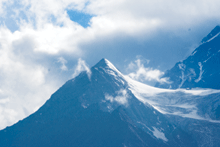 The administrative capital of Lahaul & Spiti, Keylong (pop. 30,820) is sited in the fertile Bhaga river valley. An ideal first stop-over to rest and acclimatise to high altitudes, Keylong offers several excursion options. Among them: the Guru Ghantal Monastery, sited on the banks of the river Chandra, which houses intricately carved idols of Padmasambhava (a great tantric and teacher) and Brajeshwari Devi. Unlike other monasteries in this region which house clay idols, Guru Ghantal is distinguished by its wooden figuerenes. Moreover its wooden structure with a pyramidal roof is a fine example of the region’s architecture. The Ghantal festival is celebrated on full moon night every year in the month of June. Uniquely, a stone idol of Goddess Kali graces the inner sanctum of the monastery. A must-visit is the Keylong museum. Archaeological finds from the region, tribal art, thangkha paintings and some rare Buddhist manuscripts are exhibited here.
The administrative capital of Lahaul & Spiti, Keylong (pop. 30,820) is sited in the fertile Bhaga river valley. An ideal first stop-over to rest and acclimatise to high altitudes, Keylong offers several excursion options. Among them: the Guru Ghantal Monastery, sited on the banks of the river Chandra, which houses intricately carved idols of Padmasambhava (a great tantric and teacher) and Brajeshwari Devi. Unlike other monasteries in this region which house clay idols, Guru Ghantal is distinguished by its wooden figuerenes. Moreover its wooden structure with a pyramidal roof is a fine example of the region’s architecture. The Ghantal festival is celebrated on full moon night every year in the month of June. Uniquely, a stone idol of Goddess Kali graces the inner sanctum of the monastery. A must-visit is the Keylong museum. Archaeological finds from the region, tribal art, thangkha paintings and some rare Buddhist manuscripts are exhibited here.
Accommodation. Mid-range: HPTDC Hotel Chander Bhaga, from Rs.1,000 per night; Hotel Snowland, from Rs.550. Budget: Hotel Dupchen, from Rs.200 per night; Hotel Tashi Deleg, from Rs.300
Sissu
Thirty km from Keylong is the village of Sissu (pop. 300). Perched high on the banks of the Chandra river at an altitude of 10,236 ft, Sissu offers charming vistas of pastoral rusticity amid willow and poplar forests. A patch- work of terraced potato plantations sprouting delicate yellow flowers lights up this region in the summer months. The Gyephang peak named after the deity of Lahaul, forms a picturesque backdrop to Sissu. High above the river between two mountains, the Sissu falls plunge downwards and can be accessed through a testing trek.
Gondhla
This village, a mere 18 km from Keylong houses an interesting fort, the bastion of the Thakur of Gondhla. Built in the 18th century by Raja Man Singh (king of Kullu) when he married a daughter of the Gondhla tribe, the seven storey fort constructed from timber, stone and wooden beams bound together with clay, is a marvel of architecture. Currently Gondhla fort comprises a prayer room featuring an exquisite image of Ganesha carved on a wall, and an informal museum with a collection of ancient attire and primitive weapons.
Batal
One of the most spectacular features of the Lahaul and Spiti district is Chandratal Lake. The hamlet of Batal is a preferred stop-over for the night, before heading out to the lake located 13 km away, the next morning. Batal comprises a lone tea shop which rents out tents held to the ground with stones for travellers to spend the night as the grey river Chandra flows silently into the surrounding mountains. There is nothing much to do in the wilderness of Batal except to imbibe the stark, scenic beauty of the place, listen to the wind whistling eerily against the mountains and simply losing track of time. The tea shop is a warm haven compared to the bitter cold outside, and one can spend an entire evening chatting with the pleasant Tibetan owner and his wife. This is harsh country, its secrets hidden in steep gorges and mountains, revealing itself only to tough trekkers.
Occasionally the visitor might meet a gaddi or shepherd, down from the hills nearby for a cup of tea. These shepherds bring their flock to graze all the way from Kullu in summer, because the area near the lake produces extremely nutritious grass.
Accommodation. Budget: Accommo-dation available at the dhaba in the form of little stone huts, tents or the room adjoining the tea stall, from Rs.100 per night.
Chandratal Lake
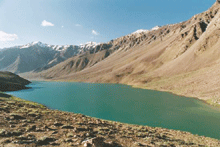 Emerging from ubiquitous barren landscapes, the first glimpse of Lake Chandratal comes as a shock, particularly since the stretch before the lake has to be covered on foot — vehicles are not allowed lakeside. After an arduous 3 km trek, the lake hoves into view. Unbelievably blue and still, it’s like a perfectly shaped piece of blue glass nestled in the mountains. The lake is the source of the River Chandra and a sacred spot for the people of the region. Its magical beauty ensures that there are several legends and myths associated with it. One popular story is that the lake marks the spot from where Yudhishtar — the eldest of the Pandava brothers of the Mahabharat — ascended to heaven in Lord Indra’s chariot.
Emerging from ubiquitous barren landscapes, the first glimpse of Lake Chandratal comes as a shock, particularly since the stretch before the lake has to be covered on foot — vehicles are not allowed lakeside. After an arduous 3 km trek, the lake hoves into view. Unbelievably blue and still, it’s like a perfectly shaped piece of blue glass nestled in the mountains. The lake is the source of the River Chandra and a sacred spot for the people of the region. Its magical beauty ensures that there are several legends and myths associated with it. One popular story is that the lake marks the spot from where Yudhishtar — the eldest of the Pandava brothers of the Mahabharat — ascended to heaven in Lord Indra’s chariot.
Accommodation. Chandratal Lake is ideal for a day trip or camping in tents at night. It is necessary to carry your own provisions and camping gear, which can also be lugged by ponies and mules. An alternative could be driving back to Batal to spend the night at the tea shop.
Spiti
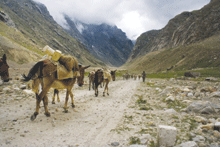 The word Spiti means ‘middle country’ because it is sited in India close to Tibet. Also known as Little Tibet, Spiti is a mountain desert with scanty vegetation and gigantic rock formations. The River Spiti flows through the region and confluences with the Sutlej river upstream in Khab. The 16,000 ft. high Kunzum pass is the natural gateway to this valley. An ancient trade route, the pass has a chorten or stupa of stones surrounded by colourful prayer flags. Like all gompas or shrines in the region, a parikrama or round of the shrine from the left to the right is mandatory before proceeding further on the road. The formidable Bara Shigri glacier, the second longest in the world, can be seen high up from the pass.
The word Spiti means ‘middle country’ because it is sited in India close to Tibet. Also known as Little Tibet, Spiti is a mountain desert with scanty vegetation and gigantic rock formations. The River Spiti flows through the region and confluences with the Sutlej river upstream in Khab. The 16,000 ft. high Kunzum pass is the natural gateway to this valley. An ancient trade route, the pass has a chorten or stupa of stones surrounded by colourful prayer flags. Like all gompas or shrines in the region, a parikrama or round of the shrine from the left to the right is mandatory before proceeding further on the road. The formidable Bara Shigri glacier, the second longest in the world, can be seen high up from the pass.
Kibber
Once known as the highest (14,200 ft) village in the world, Kibber (pop. 350) is now the altitudinally highest village accessible by tarred road worldwide. The contiguous village of Gette is sited higher up, but Kibber lives up to its fame in every way. The 80 houses of the village built of white stone with wooden latticed windows, stand proud on mountainous ridges against an inimitable backdrop of absolutely clear blue sky. Nearby is the Kibber Wildlife Sanctuary spread over an area of 1,400 sq. km, which hosts the ibex, the Tibetan wolf, lynx, red fox, the blue sheep, wild ass and the snow leopard. For visitors from India’s noisy towns and cities, this remote and isolated village offers quiet nature trails and deep peace and solitude.
Accommodation. Budget: Serkong Guesthouse, from Rs.150 per night; Norling Guesthouse, from Rs.200.
Ki Monastery
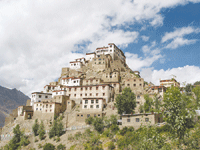 On the way down from kibber in Kaza, the sub divisional headquarters of Spiti, is the Ki Monastery, the oldest and most venerated in the valley. Dating back circa 1000 AD, its architectural style defines it as a pasada or fort monastery. Since the 17th century, it has been attacked twice by Mongol armies, the scars of which this fortress-style monastery still exhibits. A significant religious centre, it contains rare murals, scriptures, thangka paintings and musical instruments such as trumpets and cymbals used in Buddhist rituals. Visitors can often spot lamas printing prayer flags or mending their golden clogs which they wear for festivals. The interior of the monastery is a maze of labyrinths at several levels connected with stone stairs. Its tower offers a splendid view of the Spiti river snaking its way through the valley.
On the way down from kibber in Kaza, the sub divisional headquarters of Spiti, is the Ki Monastery, the oldest and most venerated in the valley. Dating back circa 1000 AD, its architectural style defines it as a pasada or fort monastery. Since the 17th century, it has been attacked twice by Mongol armies, the scars of which this fortress-style monastery still exhibits. A significant religious centre, it contains rare murals, scriptures, thangka paintings and musical instruments such as trumpets and cymbals used in Buddhist rituals. Visitors can often spot lamas printing prayer flags or mending their golden clogs which they wear for festivals. The interior of the monastery is a maze of labyrinths at several levels connected with stone stairs. Its tower offers a splendid view of the Spiti river snaking its way through the valley.
Kaza
In sharp contrast with the lonely habitations of Lahaul & Spiti district, the town of Kaza (pop. 800) seems like an overcrowded city. The fleeting faces in the windows of speeding buses or taxis can all be seen in Kaza’s cafés and streets. A base camp for excursions, Kaza has relatively superior hotel accommodation and a range of eateries mostly catering to western tourists. For most visitors, Kaza is a pit stop en route to the Tabo monastery.
Accommodation. High-end: Banjara Kunphen Retreat, from Rs.1,500 per night. Deluxe: Snow Lion Hotel, from Rs.500; The Spiti, from Rs.400. Budget: Hill View Guesthouse, from Rs.150 per night; Mahabudha Guesthouse, from Rs.200.
Tabo
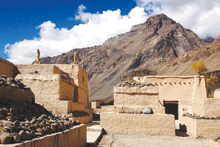 The most famous in the spiti region, the Tabo Chos Khor monastery’s origins date back to 996 AD. Designated a world heritage site by Unesco, its sanctum houses priceless scroll paintings, sculptures in stucco, frescoes and murals depicting narratives from the Mahayana Buddhist period. With 36 life-size statues solemnly lining its assembly hall, nine gompas, 23 chortens and a monks dormitory, Tabo is regarded second in importance to the famous Tholing Gompa in Tibet.
The most famous in the spiti region, the Tabo Chos Khor monastery’s origins date back to 996 AD. Designated a world heritage site by Unesco, its sanctum houses priceless scroll paintings, sculptures in stucco, frescoes and murals depicting narratives from the Mahayana Buddhist period. With 36 life-size statues solemnly lining its assembly hall, nine gompas, 23 chortens and a monks dormitory, Tabo is regarded second in importance to the famous Tholing Gompa in Tibet.
Getting there
By Air. The nearest airstrip to Lahaul & Spiti is the Kullu-Manali Airport at Bhuntar in Kullu.
By Rail. The nearest rail heads are Chandigarh, Shimla and Pathankot.
By Road. Lahaul & Spiti can be accessed via road from Manali (entry into Lahaul) and through Sumdo in Kinnaur district (entry into Spiti). However roads tend to be closed during winter (October-June) due to heavy snowfall .
|
Travel tips
• The best time to visit the Lahaul & Spiti district is from May to October.
• High altitudes can result in oxygen deprivation causing breathlessness, nausea and headaches. Visitors should budget two days for acclimatisation.
• Travelling in this region requires a fair amount of walking. Sturdy shoes, thick socks and woollens are a must because the outside temperature can drop suddenly and sharply.
• Travelling in the mountains requires patience and endurance. Landslides are common and can result in buses and taxis being stranded for hours. The roads are rough, weather conditions extreme and the thin air tests the grit and endurance of hardiest visitors.
• Equipping yourself with camping gear such as tents and sleeping bags is a good idea.
|